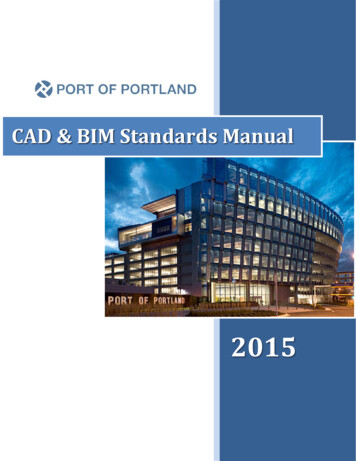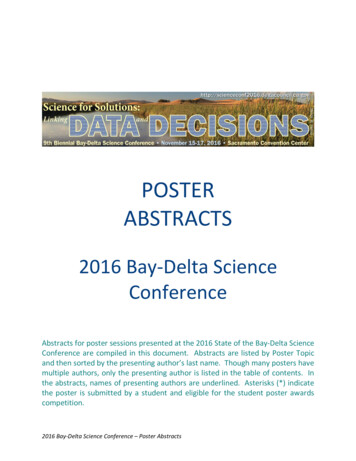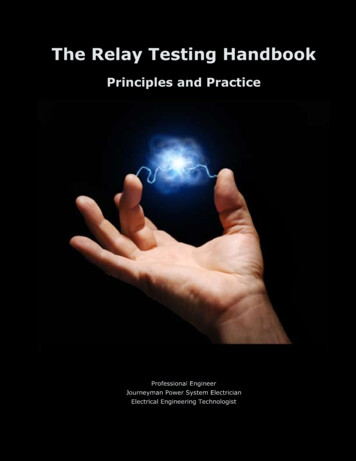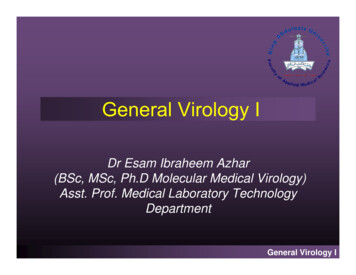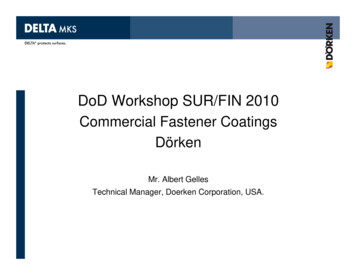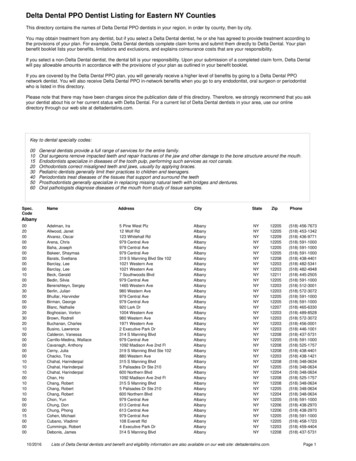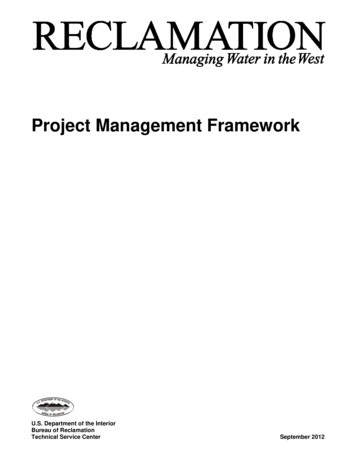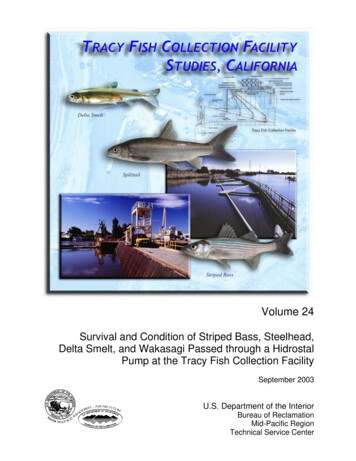
Transcription
Delta SmeltVolume 24Survival and Condition of Striped Bass, Steelhead,Delta Smelt, and Wakasagi Passed through a HidrostalPump at the Tracy Fish Collection FacilitySeptember 2003U.S. Department of the InteriorBureau of ReclamationMid-Pacific RegionTechnical Service Center
Form ApprovedOMB No. 0704-0188REPORT DOCUMENTATION PAGEPublic reporting burden for this collection of information is estimated to average 1 hour per response, including the time for reviewing instructions, searching existing data sources, gatheringand maintaining the data needed, and completing and reviewing the collection of information. Send comments regarding this burden estimate or any other aspect of this collection of information,including suggestions for reducing this burden to Washington Headquarters Services, Directorate for Information Operations and Reports, 1215 Jefferson Davis Highway, Suit 1204, ArlingtonVA 22202-4302, and to the Office of Management and Budget, Paperwork Reduction Report (0704-0188), Washington DC 20503.1. AGENCY USE ONLY (Leave Blank)2. REPORT DATESeptember 20033. REPORT TYPE AND DATES COVERED4. TITLE AND SUBTITLETracy Fish Collection Facility Studies, California, Volume 24, Survival andCondition of Striped Bass, Steelhead, Delta Smelt, and Wakasagi Passedthrough a Hidrostal Pump at the Tracy Fish Collection Facility5. FUNDING NUMBERS6. AUTHOR(S)Louis A. Helfrich, Raymond C. Bark, Charles R. Liston, and Brent Mefford7. PERFORMING ORGANIZATION NAME(S) AND ADDRESS(ES)U.S. Department of the InteriorBureau of ReclamationTechnical Service Center, D-8290P.O. Box 25007Denver CO 80225-0007U.S. Department of the InteriorBureau of ReclamationResources Management Division, MP-4002800 Cottage WaySacramento CA 95825-18989. SPONSORING/MONITORING AGENCY NAME(S) AND ADDRESS(ES)8. PERFORMING ORGANIZATIONREPORT NUMBERVolume 2410. SPONSORING/MONITORINGAGENCY REPORT NUMBER11. SUPPLEMENTARY NOTES12a. DISTRIBUTION/AVAILABILITY STATEMENTAvailable from the National Technical Information Service, OperationsDivision, 5285 Port Royal Road, Springfield, Virginia 2216112b. DISTRIBUTION CODE13. ABSTRACT (Maximum 200 words)A 41-cm diameter Wemco-Hidrostal pump was evaluated for fish passage as part of research to improvesalvage operations at the Bureau of Reclamation's Tracy Fish Collection Facility, Tracy, California.Immediate and 96-hour (h) mortality, descaling, and injury rates were evaluated for striped bass, Moronesaxatilis, steelhead, Oncorhynchus mykiss, wakasagi, Hypomesus nipponensis, and delta smelt, Hypomesustranspacificus. Test fish inserted into the intake of the Hidrostal pump were compared to control fish thatwere inserted into the exit. The pump had no significant effect on immediate or 96-h mortality for all speciestested, with immediate and 96-h mortality below 3 percent for all trials. Averaged scale loss was below2.6 percent for all species. Some non-lethal injuries to the head, eyes, skin, and fins of pumped fish occurred;however, these injuries were not significantly different among quality control, control, and treatment fish.No statistically significant relationships were detected between fish mortality and pump speed, injected fishdensity, or debris load. Wakasagi appeared to be more tolerant to pump passage than Delta smelt and maynot be an appropriate surrogate species for delta smelt. Our results suggest that large Hidrostal pumps havethe capacity to transport live fish with low mortality and minimal body injury.15. NUMBER OF PAGES14. SUBJECT TERMS—Hidrostal fish friendly pump, fish salvage, Sacramento-San Joaquin Delta,Tracy Fish Collection Facility, striped bass, delta smelt, wakasagi, steelhead17. SECURITY CLASSIFICATIONOF REPORTULNSN 7540-01-280-550018. SECURITY CLASSIFICATIONOF THIS PAGEUL19. SECURITY CLASSIFICATIONOF ABSTRACTUL3516. PRICE CODE20. LIMITATION OF ABSTRACTULStandard Form 298 (Rev. 2-89)Prescribed by ANSI Std. 239-18298-102
TRACY FISH COLLECTIONFACILITY STUDIESCALIFORNIAVolume 24Survival and Condition of Striped Bass, Steelhead,Delta Smelt, and Wakasagi Passed through aHidrostal Pump at the Tracy Fish Collection FacilitybyLouis A. Helfrich1Raymond C. Bark2Charles R. Liston3Brent Mefford4September 2003United States Department of the InteriorBureau of ReclamationMid-Pacific RegionTechnical Service Center1Virginia Polytechnic Institute and State UniversityDepartment of Fisheries and Wildlife Science152 Cheatham HallBlacksburg VA 240612U.S. Department of the Interior - Bureau of ReclamationTechnical Service Center - Fisheries Applications and Research, D-8290P.O. Box 25007Denver CO 80225-00073U.S. Department of the Interior - Bureau of ReclamationResources Management Division, MP-4002800 Cottage WaySacramento CA 95825-18984U.S. Department of the Interior - Bureau of ReclamationTechnical Service Center - Water Resources Research Laboratory, D-8560P.O. Box 25007Denver CO 80225-0007
MISSION STATEMENTSThe mission of the Department of the Interior is to protect and provideaccess to our Nation’s natural and cultural heritage and honor our trustresponsibilities to Indian tribes and our commitments to island communities.The mission of the Bureau of Reclamation is to manage, develop, and protectwater and related resources in an environmentally and economically soundmanner in the interest of the American public.SERIES EDITORDoug CraftU.S. Department of the Interior - Bureau of ReclamationTechnical Service Center - Fisheries Applications Research Group, D-8290PO Box 25007Denver CO 80225-0007COVERFish photography by Rene Reyes, Tracy Fish Collection Facility, Tracy, California.Design by Doug Craft.DISCLAIMERMention of commercial products does not constitute endorsement.
Tracy Series Volume 24Helfrich, Bark, Liston, and MeffordTABLE OF CONTENTSPageAbstract . . . . . . . . . . . . . . . . . . . . . . . . . . . . . . . . . . . . . . . . . . . . . . . . . . . . . . . . . . . . . iiiExecutive Summary . . . . . . . . . . . . . . . . . . . . . . . . . . . . . . . . . . . . . . . . . . . . . . . . . . . iiiIntroduction . . . . . . . . . . . . . . . . . . . . . . . . . . . . . . . . . . . . . . . . . . . . . . . . . . . . . . . . . . 1Methodology . . . . . . . . . . . . . . . . . . . . . . . . . . . . . . . . . . . . . . . . . . . . . . . . . . . . . . . . . 3Results and Discussion . . . . . . . . . . . . . . . . . . . . . . . . . . . . . . . . . . . . . . . . . . . . . . . . 7Striped Bass . . . . . . . . . . . . . . . . . . . . . . . . . . . . . . . . . . . . . . . . . . . . . . . . . . . . . . 7Steelhead . . . . . . . . . . . . . . . . . . . . . . . . . . . . . . . . . . . . . . . . . . . . . . . . . . . . . . . 11Delta Smelt and Wakasagi . . . . . . . . . . . . . . . . . . . . . . . . . . . . . . . . . . . . . . . . . . 11Wild Fish . . . . . . . . . . . . . . . . . . . . . . . . . . . . . . . . . . . . . . . . . . . . . . . . . . . . . . . . 16Conclusions . . . . . . . . . . . . . . . . . . . . . . . . . . . . . . . . . . . . . . . . . . . . . . . . . . . . . . . . 20Acknowledgments . . . . . . . . . . . . . . . . . . . . . . . . . . . . . . . . . . . . . . . . . . . . . . . . . . . 22References . . . . . . . . . . . . . . . . . . . . . . . . . . . . . . . . . . . . . . . . . . . . . . . . . . . . . . . . . 22FiguresFigurePage1Wemco-Hidrostal centrifugal pump used for the fish passageexperiments . . . . . . . . . . . . . . . . . . . . . . . . . . . . . . . . . . . . . . . . . . . . . . . . . . . . 42Cross section view of the Hidrostal pump and fish injection ports (fishprotective impeller shroud is not shown in this drawing) . . . . . . . . . . . . . . . 53Collection pool where fish were collected by handnet . . . . . . . . . . . . . . . . . . . 6September 2003 P Page i
Tracy Series Volume 24Helfrich, Bark, Liston, and MeffordTable of Contents - continuedTablesTablePage1Mean percent immediate (0-h) and 96-h survival of stripedbass passed through the Hidrostal pump (treatment) and those ofthe control fish during 169 trials . . . . . . . . . . . . . . . . . . . . . . . . . . . . . . . . . . . 82Mean percent body scaling and percent fish injured for quality control(handling), control (no pump passage), and treatment (pump passage)groups of striped bass . . . . . . . . . . . . . . . . . . . . . . . . . . . . . . . . . . . . . . . . . . . 103Mean percent immediate (0-h) and 96-h survival of steelhead passedthrough the Hidrostal pump (treatment) and those of the control fishduring 86 trials . . . . . . . . . . . . . . . . . . . . . . . . . . . . . . . . . . . . . . . . . . . . . . . . 124Mean percent body descaling and percent injured fish for quality control(handling), control (no pump passage), and treatment (pump passage)groups of steelhead . . . . . . . . . . . . . . . . . . . . . . . . . . . . . . . . . . . . . . . . . . . . . 135Mean percent immediate (0-h) and 96-h survival of delta smelt passedthrough the Hidrostal pump (treatment) and those of the control fishduring 34 trials . . . . . . . . . . . . . . . . . . . . . . . . . . . . . . . . . . . . . . . . . . . . . . . . 146Mean percent injured fish for quality control (handling), control (nopump passage), and treatment (pump passage) groups of delta smelt . . . . 157Mean percent immediate (0-h) and 96-h survival of wakasagi passedthrough the Hidrostal pump (treatment) and those of the control fishduring 29 trials . . . . . . . . . . . . . . . . . . . . . . . . . . . . . . . . . . . . . . . . . . . . . . . . 178Mean percent injured fish for quality control (handling), control (nopump passage), and treatment (pump passage) groups of wakasagi . . . . . . 189Numbers and sizes of wild fish entrained during the pumping trials . . . . . 19Page ii P Tracy Fish Collection Facility Studies
Tracy Series Volume 24Helfrich, Bark, Liston, and MeffordABSTRACTA 41-cm diameter Wemco-Hidrostal pump was evaluated for fish passage aspart of research to improve salvage operations at the Bureau of Reclamation’sTracy Fish Collection Facility, Tracy, California. Immediate and 96-hour (h)mortality, descaling, and injury rates were evaluated for striped bass, Moronesaxatilis, steelhead, Oncorhynchus mykiss, wakasagi, Hypomesusnipponensis, and delta smelt, Hypomesus transpacificus. Test fish insertedinto the intake of the Hidrostal pump were compared to control fish that wereinserted into the exit. The pump had no significant effect on immediate or96-h mortality for all species tested, with immediate mortality less than3 percent and 96-h mortality below 13 percent for all trials. Averaged scaleloss was below 2.6 percent for all species. Some non-lethal injuries to thehead, eyes, skin, and fins of pumped fish occurred; however, these injurieswere not significantly different among quality control, control, and treatmentfish. No statistically significant relationships were detected between fishmortality and pump speed, injected fish density, or debris load. Wakasagiappeared to be more tolerant to pump passage than delta smelt and may notbe an appropriate surrogate species for delta smelt. Our results suggest thatlarge Hidrostal pumps have the capacity to transport live fish with lowmortality and minimal body injury.EXECUTIVE SUMMARYA 41-cm diameter Wemco-Hidrostal pump was evaluated for fish passage aspart of research to improve salvage operations at the Bureau of Reclamation’sTracy Fish Collection Facility, Tracy, California. Immediate and 96-hmortality, descaling, and injury rates of striped bass, Morone saxatilis,steelhead Oncorhynchus mykiss, wakasagi, Hypomesus nipponensis, anddelta smelt, Hypomesus transpacificus, that were inserted into the entrance(suction side) of a Hidrostal pump were compared to those of control fish thatwere inserted at the exit (pressure side). Comparisons were made in168 paired trials with striped bass, 86 trials with steelhead, 34 trials withdelta smelt, and 29 trials of wakasagi.The Hidrostal pump had no significant effect on immediate or 96-h mortalityof striped bass and steelhead. Immediate mortality for pumped striped bassand steelhead averaged 0.1 and 0 percent, respectively, and 96-h mortalityaveraged 4.6 and 0.1 percent, respectively. Immediate and 96-h mortality forSeptember 2003 P Page iii
Tracy Series Volume 24Helfrich, Bark, Liston, and Mefforddelta smelt (mean, 0.5 and 12.9 percent) and wakasagi (2.5 and 4 percent)was similarly low.Mean scale loss after pump passage for striped bass and steelhead was low,averaging 0.2 percent and 2.6 percent, respectively. Scale loss analysis wasnot possible on delta smelt or wakasagi. Frequency of body injury to thehead, eyes, skin, and fins of pumped striped bass averaged 14.0, 2.0, 7.5, and40 percent, respectively, and those of steelhead averaged 3.5, 0.1, 4.7, and62.5 percent. Frequency of body injury to the head, eyes, skin, and fins ofpumped delta smelt averaged 0, 0, 0, and 19.0 percent, and those of wakasagiaveraged 9.1, 0, 0, and 27.0 percent. These injuries were non-lethal and notsignificantly different among quality control, control, and treatment fish.Relatively high fin abrasion was largely the result of holding and handlingconditions, rather than pump effect.No consistently significant relationships were detected between fishmortality and pump speed, injected fish density, or debris load. Wakasagiappeared to be a hardier species (subspecies), slightly more tolerant to pumppassage than delta smelt and, therefore, may not be an appropriate surrogatespecies for delta smelt. Our results suggest that large Hidrostal pumps havethe capacity to transport live fish at high density with little mortality andbody injury.Page iv P Tracy Fish Collection Facility Studies
Tracy Series Volume 24Helfrich, Bark, Liston, and MeffordINTRODUCTIONThe Tracy Fish Collection Facility (TFCF) was constructed in the 1950s bythe U.S. Department of the Interior, Bureau of Reclamation (Reclamation), tointercept and salvage fish that had become entrained into water beingdiverted into the Delta Mendota Intake Channel in the SacramentoSan Joaquin Delta (Delta), California (Liston et al., 1993). Following severalyears of testing and development, a louver system was installed to guide fishinto holding tanks prior to transport back to Delta waters. Fish areconcentrated in holding tanks with accumulating debris for several hoursbefore being lifted into transport tanks (Bureau of Reclamation, 1957).Stresses associated with holding (circular swirling currents) and subsequenttransfer to fish hauling trucks with a bucket may stress fish and reduce theirsurvival following transport and release in the San Joaquin River.During the late 1980s, Reclamation began implementing studies andprocesses at TFCF to increase the understanding of fish problems at thefacility, aimed at eventually improving the TFCF through alterations ofthe existing system or possible total facility replacement (Liston et al., 2000).This group of activities was collectively called the Tracy Fish FacilityImprovement Program (TFFIP) by Reclamation, which was given morevalidity and necessity by passage of the Central Valley Project ImprovementAct (CVPIA) in 1992. An especially significant requirement of the CVPIA isin Section 3406(b)(4), which states that Reclamation must “develop andimplement a program to mitigate for fishery impacts associated withoperations of the Tracy Pumping Plant. Such a program shall include, but isnot limited to, improvement or replacement of the fish screens and fishrecovery facilities and practices associated with the Tracy Pumping Plant.”Developing technologies for TFCF to replace recessed holding tanks was oneapproach considered to address CVPIA requirements. If fish could be liftedto above ground holding tanks where flows could be controlled and debrisremoved prior to transport, fish stress may be reduced. Earlier work usingfish-friendly internal screw type pumps at TFCF (Hiebert, 1994), other sites(Patrick and Sim, 1985; Rodgers and Patrick, 1985; Patrick and McKinley,1987), and at Red Bluff, California (McNabb et al., 2003) indicated highsurvival of pumped fish. Reclamation installed a Hidrostal pump and tanksystem in 1998 at TFCF, and successful fish passage was determined, bothfor experimentally introduced juvenile chinook salmon, Oncorhynchustshawytscha, splittail, Pogonichthys macrolepidotus, and incidentallySeptember 2003 P Page 1
Tracy Series Volume 24Helfrich, Bark, Liston, and Meffordentrained fish of 26 other species (Helfrich et al., 2001). Especially notablewere 108 juvenile delta smelt, Hypomesus transpacificus, passed through thepump with high (99 percent) immediate survivorship.Fish passage and protection at water export facilities and at dams arefundamental to maintaining and restoring anadromous and nonanadromousfishes. The cumulative impact of dams, hydropower facilities, and irrigationwater diversions on riverine fish populations has become increasinglyapparent with the decline of Pacific salmon species and other fish stocks(Nemeth and Kiefer, 1999; Williams et al., 1999). Catastrophic ecological andeconomic consequences have accompanied the collapse of importantcommercial and recreational fisheries as a result of dam impassability andcanal and turbine entrainment of fish (National Research Council, 1996).Moreover, the occurrence of threatened species such as the delta smelt, afederally listed threatened species, entrained in water export facilities, cansignificantly alter operations. Collection of delta smelt, in numbers greaterthan the “take threshold” set by State and Federal fisheries regulatoryagencies (U.S. Fish and Wildlife Service, National Marine Fisheries Service,California Department of Fish and Game), initiates a series of actionsincluding reduced water export rates. Methods to minimize entrainment andmaximize survival and recovery of threatened and endangered species isimperative for predictable water delivery for irrigation and municipal uses.Here we test the sensitivity of both delta smelt and wakasagi, Hypomesusnipponensis, a similar, unprotected exotic species that is taxonomicallynearly indistinguishable from delta smelt.Significant declines in worldwide river fisheries may be partially mitigatedby using less damaging pumping technologies. The Hidrostal pump, whichuses a screw-type centrifugal impeller and has been used to move fruits andproduce for shipping without damage, may prove useful for the safe passageof fish at dams and at water export facilities. Pumps that can safelytransport fish from a water diversion canal through a bypass return to a riveror around a dam would have significant fisheries management applications.Few comprehensive investigations of Hidrostal pump systems with fish havebeen published. Limited evaluations of small (15 and 25 cm diameter inlet)Hidrostal pumps have demonstrated relatively low mortality (0–28 percent)and injury rates ( 3 percent) for a few species and sizes of fish (Baldwin,1973; Rodgers and Patrick, 1985; Patrick and McKinley, 1987; Grizzle et al.,1992; Grizzle and Lovshin, 1994; Wagner and Driscoll, 1994). However, thePage 2 P Tracy Fish Collection Facility Studies
Tracy Series Volume 24Helfrich, Bark, Liston, and Meffordfeasibility of using a large (41 cm diameter) Hidrostal pump to movecommercial volumes of water and transfer diverse species of fishes, sizes, anddensities over a range of pump speeds back into a river system is uncertain.The objectives of this research were to assess survival, descaling, and injuryrates of striped bass, Morone saxatilis, steelhead, Oncorhynchus mykiss,wakasagi, and delta smelt transported by a large Hidrostal pump and torelate fish mortality and injury to pump speed, fish density injected, anddebris load.METHODOLOGYThe Reclamation Tracy Pumping Plant (TPP), located in the Central Valley ofCalifornia, exports over 678 million cubic meters of water per year into theDelta Mendota Canal (DMC) for irrigation, municipal, and industrial waterneeds. The TFCF, located 2 miles upstream from the TPP, was designed toexclude adult sport fish inhabiting the Sacramento and San Joaquin riversfrom export water (Helfrich et al., 1999). At the TFCF, fish are directed bylouvers into underground tanks where they are held for stocking back intothe Sacramento-San Joaquin Delta.A 41-cm diameter Hidrostal pump (internal helical, centrifugal) built byWemco Pump (EnviroTech Pumpsystems) was installed at the TFCF inOctober 1998 for these experiments (figure 1). The Hidrostal pump used waslarger but similar in design to helical pumps that have been widely used inthe aquaculture industry to grade, harvest, and move fish. This pump wasdesigned to minimize shear, pressure change, turbulence, and abrasion. Thescrew-type impeller is completely enclosed (shrouded) to protect the fish. Thepump is turned by a 50-hp electric motor controlled with a variable speeddrive to produce selected water discharge and velocity. During these trials,pump speed ranged from 461 to 601 revolutions per minute (r/min) and waterflows ranged from 178 to 299 L/s, depending on canal hydraulics and tidalconditions. Pumping time per trial ranged from 5 to 10 minutes.Experimental trials were conducted during December 1999 throughFebruary 2002. Months were selected to evaluate passage through thepump by native and non-native species during different seasons and overa range of environmental conditions. Dissolved oxygen (DO), pH, watertemperature (T), electrical conductivity (EC), and salinity were all withinthe physiological limits for fish. DO ranged from 9.9 to 8.4 mg/L, pH fromSeptember 2003 P Page 3
Tracy Series Volume 24Helfrich, Bark, Liston, and MeffordFIGURE 1.—Wemco-Hidrostal centrifugal pump used for the fish passageexperiments.7.3 to 8.2, T from 8.8 to 24.1 C, EC from 0.09 to 0.65 mS/cm, and salinityfrom 0.01 to 0.33 parts per thousand. All herbaceous and woody debrisnaturally entrained in the pump were weighed (wet weight) for each trial.Striped bass (mean 177 mm total length; range 78 to 360 mm) werecollected from the TFCF. Steelhead (mean 252 mm total length; range165 to 313 mm) were obtained from California Department of Fish and GameNimbus Hatchery, Rancho Cordova, California. Delta smelt were reared atthe State of California Skinner Aquaculture Facility using eggs collected fromwild adults in the Spring 2001. Wakasagi were collected using seine and dipnets from San Luis Reservoir, Gustine, California.All experimental fish were held in well water near 18 C, and acclimated for24 hours in canal water at ambient temperatures before the experiments.Fish were carefully handled and transferred in water treated with a solutionof NaCl (5 g/L) and PolyAqua (0.13 mL/L) to promote osmotic balance andreduce stress. In some trials, striped bass were marked with bismarck browndye one day prior to the experiments to distinguish them from similar sizewild fish entrained during the trials. Steelhead, delta smelt, and wakasagiin most trials were marked with photonic color dye injected into the fins.Page 4 P Tracy Fish Collection Facility Studies
Tracy Series Volume 24Helfrich, Bark, Liston, and MeffordAfter the Hidrostal pump was operating at constant test speed, a group oftreatment fish (n 4 to 42), held in water-filled plastic bags, were insertedwith water flow into a 30.5-cm diameter port (standpipe) located immediatelyupstream (suction side) of the pump (figure 2). Fish were released from thebag into the flow. Fish remaining in the standpipe were forced into the flowby inserting a fish crowder and slowly pushing it downward in the standpipe.In separate paired control trails, fish were subjected to the same conditionsas the treatment fish, but were inserted into a standpipe downstream(pressure side) of the pump. Paired treatment and control trials were testedconsecutively and simultaneously to assure that experimental fishexperienced identical physical and chemical conditions. Fish densitiesinstantly injected into the pump ranged from 4 to 42 fish per trial dependingon the species and sizes used. After injection, treatment and control fishwere lifted in the flow 3.7 m vertically and conveyed 13.7 m horizontallythrough smooth pipe and discharged into a large rectangular holding pool(4.4 x 9.0 x 1.2 m deep).The holding pool (figure 3) was designed to convey a 400 L/s flow at anControl fishinsertion portTreatment fishin ertion portllTo fishcollectionpoolFIGURE 2.—Cross section view of the Hidrostal pump and fish injection ports(fish protective impeller shroud is not shown in this drawing).September 2003 P Page 5
Tracy Series Volume 24Helfrich, Bark, Liston, and Meffordaverage velocity of 3.67 cm/s in order to reduce the potential for fishimpingement on the rotating debris screen at the pool discharge. Fish werecollected by handnet in the pool sump, (4.4 x 0.6 x 0.3 m deep) after excesswater was gradually drained through a rotating drum screen (perforatedplate, 0.24-cm mesh). The rotating drum screen was mounted at thedownstream end of the holding pool to prevent escape of fish and to removedebris. A stationary perforated plant (0.24-cm mesh) was placed diagonallyin front of the sump drain to prevent escape of fish and to collect and removedebris for analysis.FIGURE 3.—Collection pool where fish were collected by handnet.Before each trial, two fish from each live cage were randomly selected to bequality controls to determine potential handling and transport impact.Quality control fish were compared to all post-treatment and post-control fishafter each trial by microscopic analysis for descaling and physical injury.Quality control fish were used to establish base line injury levels for nonpump related handling and holding conditions in the aquaculture facility.For descaling analyses, 100 percent of the total scaled body surface wasmicroscopically examined and scale loss (as a percent of body surface area)was estimated according to Kostecki et al. (1987). Body injury rates (percentPage 6 P Tracy Fish Collection Facility Studies
Tracy Series Volume 24Helfrich, Bark, Liston, and Meffordof fish) were used to enumerate any abnormalities or abrasions to the head,eyes, skin, and fins.After each trial, survival rates of fish in the holding pool were recorded. Twolive fish from each trial were anesthetized with an overdose ( 300 mg/L) oftricaine methanesulfonate (MS-222), placed in a plastic bag with water, andexamined for descaling and external injury within 60 minutes of collection. Anon-lethal dose of MS-222 was used to relax the fish during examination forall steelhead and some of the striped bass trials. The remaining fish weretransferred to live cages and examined for 96-h mortality at 24-h intervals forfour days.Paired trials (n 2 to 25 per month) were conducted for each treatment(pump passage) and control (no pump passage) group for striped bass,steelhead, delta smelt, and wakasagi. Our null hypothesis, Ho, was: nodifference between control and treatment fish in mean immediate survival,96-h survival, descaling, or body injury rates.The Wilcoxon signed-rank test was used to test for differences in survivalbetween paired treatment and control groups for each monthly testingperiod. Variables were group (treatment or control) and time after pumppassage (0, 24, 48, 72, and 96 h). The Kolmogorov-Smirnov test for goodnessof fit (Sokal and Rohlf, 1981; Zar, 1984) was used to examine differences infrequency distributions between descaling and body injury among treatment,control, and quality control (handling) groups. Regression analysis was usedto detect any significant relationships between 96-h survival and injected fishdensity of striped bass and steelhead. Expected frequencies were computedfor data on the control group trials. An alpha level of 0.05 was used as thecriterion for detecting statistical significance.RESULTS AND DISCUSSIONStriped BassImmediate survival after pump passage for striped bass (table 1) was high,averaging 99 percent, and did not differ significantly between treatment andcontrol groups (Wilcoxon sign rank test, z 1.3, P 0.18). Four-day survivalafter pump passage remained high, averaging 96 percent, and no differencesSeptember 2003 P Page 7
Page 8 P Tracy Fish Collection Facility StudiesFish(n)Trials(n)169169All 00h121712000000000003001062248 h131348 h394772 h000000000000000039470072 hDaily Mortality (n)24 h0103000110000010575524 hDaily Mortality (n)729096 h120001000201000071840096 99.210077.574.497.797.796 h10099.90h96.795.496 hSurvival Rate 001001001001001001000hSurvival Rate 280276269278239227201201Flow(L/s)503503Pump 9540541546507500482482Pump Speed(r/min)TABLE 1.—Mean percent immediate (0-h) and 96-h survival of striped bass passed through the Hidrostal pump (treatment) and those of the control fish during 169 trialsTracy Series Volume 24Helfrich, Bark, Liston, and Mefford
Tracy Series Volume 24Helfrich, Bark, Liston, and Meffordbetween treatment and control groups for striped bass (z 2.19, P 0.28)were detected. Unusually high 96-h mortality (20 percent) of control andtreatment striped bass during February 2000 resulted from reduced aerationand oxygen flow to the holding tanks and was unrelated to pump effects.Fish survival (percent, was unrelated to pump speeds between 409 to598 r/min (r2 0.01, P 0.3
P.O. Box 25007 2800 Cottage Way Denver CO 80225-0007 Sacramento CA 95825-1898 . Doug Craft U.S. Department of the Interior - Bureau of Reclamation Technical Service Center - Fisheries Applications Research Group, D-8290 PO Box 25007 Denver CO 80225-0007. C. OVER . Fish photography
